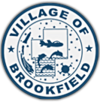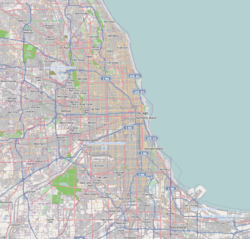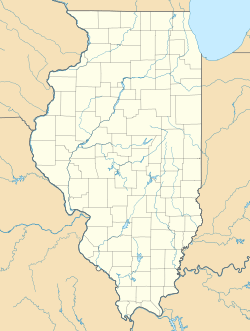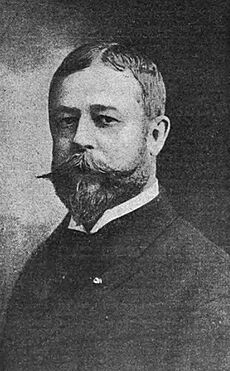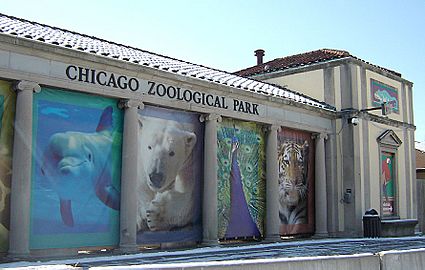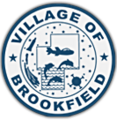Brookfield, Illinois facts for kids
Quick facts for kids
Brookfield, Illinois
|
|||
|---|---|---|---|
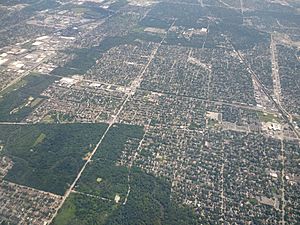
Part of Brookfield and neighboring La Grange Park
|
|||
|
|||
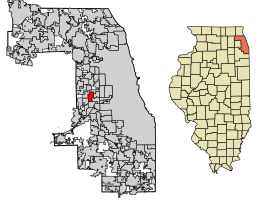
Location of Brookfield in Cook County, Illinois
|
|||
| Country | |||
| State | Illinois | ||
| County | Cook | ||
| Township | Lyons, Proviso, Riverside | ||
| Incorporated | 1893 | ||
| Government | |||
| • Type | Village-manager | ||
| Area | |||
| • Total | 3.07 sq mi (7.95 km2) | ||
| • Land | 3.06 sq mi (7.93 km2) | ||
| • Water | 0.01 sq mi (0.02 km2) 0.33% | ||
| Population
(2020)
|
|||
| • Total | 19,476 | ||
| • Density | 6,356.40/sq mi (2,454.48/km2) | ||
| Down 0.56% from 2000 | |||
| Standard of living (2007-11) | |||
| • Per capita income | $31,651 | ||
| • Median home value | $263,600 | ||
| ZIP Code |
60513
|
||
| Area code | 708 | ||
| Geocode | 17-08576 | ||
| FIPS code | 17-08576 | ||
Brookfield, once called Grossdale, is a village in Cook County, Illinois, USA. It's about 13 miles west of downtown Chicago. In 2020, nearly 19,500 people lived there. Brookfield is famous for being home to the Brookfield Zoo.
Contents
History of Brookfield
Long ago, before 1803, the land where Brookfield now stands was covered with prairies and forests. Native American tribes lived here. They were skilled farmers, growing corn and creating beautiful pottery. They also built villages and burial mounds.
How Brookfield Started
The village started in 1889. A lawyer named Samuel Eberly Gross bought land here. He turned it into building lots for homes. This new area was along the Chicago, Burlington & Quincy Railroad line. This train line connected Chicago and Aurora, Illinois. Samuel Gross called his new development 'Grossdale'. He wanted to offer affordable homes. This made it possible for working families to live in the suburbs.
The first two buildings Gross built were a train station and a pavilion. The train station was for passengers. The pavilion had the first post office and a general store. It also held Gross's real estate office and meeting rooms. Sometimes, it was even used as a dance hall.
Samuel Gross would offer free train trips from Chicago to Grossdale. People interested in buying land would come. A band would greet them at the station. They would enjoy a picnic lunch. Then, Gross would give his sales pitch. He offered land and house designs at good prices.
Changing the Name to Brookfield
Gross later added more areas called Hollywood (in 1893) and West Grossdale (in 1895). Each of these areas had its own train station. In 1893, residents voted to officially become the village of Grossdale.
However, residents became unhappy with Samuel Gross. His personal life and money problems grew. So, in 1905, they decided to change the village's name. They held a contest to choose a new name. The winning name was "Brookfield." This name was chosen because of Salt Creek, which flows through the area. There is also a school named S.E. Gross after him.
Modern Connections and the Zoo
In 1920, the old Plank Toll Road was paved. This road is now called Ogden Avenue (US Hwy 34). This made it much easier for cars to travel to and from Chicago.
The Brookfield Zoo opened in 1934. It is also known as the Chicago Zoological Park. The land for the zoo was given by Edith Rockefeller McCormick in 1919.
Geography of Brookfield
Brookfield is located at 41°49′22″N 87°50′51″W / 41.82278°N 87.84750°W.
Most of Brookfield is flat land. It has some small hills and gentle rises. Along Salt Creek, there is a steep valley. This valley is home to many oak savannas. These oak savannas are the main type of natural area in Brookfield. They spread out from large forests into smaller patches across the village.
People of Brookfield (Demographics)
| Historical population | |||
|---|---|---|---|
| Census | Pop. | %± | |
| 1900 | 1,111 | — | |
| 1910 | 2,186 | 96.8% | |
| 1920 | 3,589 | 64.2% | |
| 1930 | 10,035 | 179.6% | |
| 1940 | 10,817 | 7.8% | |
| 1950 | 15,472 | 43.0% | |
| 1960 | 20,429 | 32.0% | |
| 1970 | 20,284 | −0.7% | |
| 1980 | 19,395 | −4.4% | |
| 1990 | 18,876 | −2.7% | |
| 2000 | 19,085 | 1.1% | |
| 2010 | 18,978 | −0.6% | |
| 2020 | 19,476 | 2.6% | |
| U.S. Decennial Census 2010 2020 |
|||
As of the 2020 census, there were 19,476 people living in Brookfield. There were 6,988 households. A household means all the people living in one home.
About 35.3% of households had children under 18 living with them. About 54% were married couples. The average household had 3.23 people. The average family had 2.63 people.
The median age in the village was 40.1 years. This means half the people were older and half were younger than 40.1. About 26.3% of the population was under 18 years old.
The median income for a household was $84,891. For a family, it was $103,072. The per capita income (income per person) was $38,222.
| Race / Ethnicity (NH = Non-Hispanic) | Pop 2000 | Pop 2010 | Pop 2020 | % 2000 | % 2010 | % 2020 |
|---|---|---|---|---|---|---|
| White alone (NH) | 16,961 | 14,888 | 12,791 | 88.87% | 78.45% | 65.68% |
| Black or African American alone (NH) | 165 | 456 | 597 | 0.86% | 2.40% | 3.07% |
| Native American or Alaska Native alone (NH) | 16 | 11 | 27 | 0.08% | 0.06% | 0.14% |
| Asian alone (NH) | 235 | 285 | 346 | 1.23% | 1.50% | 1.78% |
| Pacific Islander alone (NH) | 2 | 0 | 3 | 0.01% | 0.00% | 0.02% |
| Other race alone (NH) | 4 | 11 | 52 | 0.02% | 0.06% | 0.27% |
| Mixed race or Multiracial (NH) | 165 | 258 | 640 | 0.86% | 1.36% | 3.29% |
| Hispanic or Latino (any race) | 1,537 | 3,069 | 5,020 | 8.05% | 16.17% | 25.78% |
| Total | 19,085 | 18,978 | 19,476 | 100.00% | 100.00% | 100.00% |
Local Newspapers
In the past, Brookfield had several newspapers. These included The Suburban Magnet and Brookfield Star. The most successful newspaper was the Brookfield Enterprise. It started in 1932 and stopped publishing in 1985.
Schools in Brookfield
Brookfield has several elementary school districts. These include Brookfield School District 95, LaGrange School District 102, Lyons School District 103, and Riverside School District 96.
District 95 is the main elementary school district for Brookfield. It has one elementary school, Brook-Park Elementary. It also has one junior high school, S.E. Gross Middle School.
After elementary school, most teens attend Riverside Brookfield High School. Some students from other districts go to Lyons Township High School. This high school has campuses in La Grange and Western Springs.
Getting Around Brookfield (Transportation)
Brookfield is still connected to the old Chicago, Burlington & Quincy train line. Now, Metra's BNSF Line serves three stations in the area. These stations are Congress Park, Brookfield, and Hollywood. Metra trains run daily between Chicago and Aurora.
You can also find Pace bus stops throughout the village. The Salt Creek Trail is also available for walking or biking.
Fun Things to Do in Brookfield (Attractions)
- The Brookfield Zoo is managed by the Chicago Zoological Society. It is open every day of the year.
- The Galloping Ghost Arcade is the largest video arcade in the United States. It has over 976 video games, including retro and modern ones.
- North Kiwanis Park hosts many yearly events. These include German Fest, Fall Fest, and the Brookfield Fourth of July Parade.
- The Brookfield oak savannas are a popular nature preserve. You can find many animal and plant species there.
- The Grossdale Train Station is now home to the Brookfield Historical Society. It is the oldest building in Brookfield. It was built in the 1880s, even before the village was officially founded.
- Salt Creek flows through many suburbs. It is a branch of the Des Plaines River. The creek is wide and long. It has calm water, good fishing, and lots of wildlife.
- Jaycee Ehlert Park is the largest park in Brookfield. It has a North American F-86L Sabre plane on display. This plane is a memorial for the Korean War.
Notable People from Brookfield
- William L. Blaser, an Illinois state representative and businessman.
- Milt Bocek, a former outfielder for the Chicago White Sox baseball team.
- Michael Colgrass, a composer who won a Pulitzer Prize.
- Jim Holvay, a guitarist and songwriter for the band The Mob. He wrote hit songs for The Buckinghams.
- Chris Klein (actor), an actor.
- Tom Kondla, a basketball player for the Minnesota Pipers and Houston Mavericks.
- Joy Layne, a pop singer from the 1950s.
- George Marsh, a Medal of Honor recipient from the American Civil War.
- Lou Saban, a football player and coach for many teams.
- Allen C. Skorepa, a lichenologist (someone who studies lichens).
Images for kids
See also
 In Spanish: Brookfield (Illinois) para niños
In Spanish: Brookfield (Illinois) para niños



